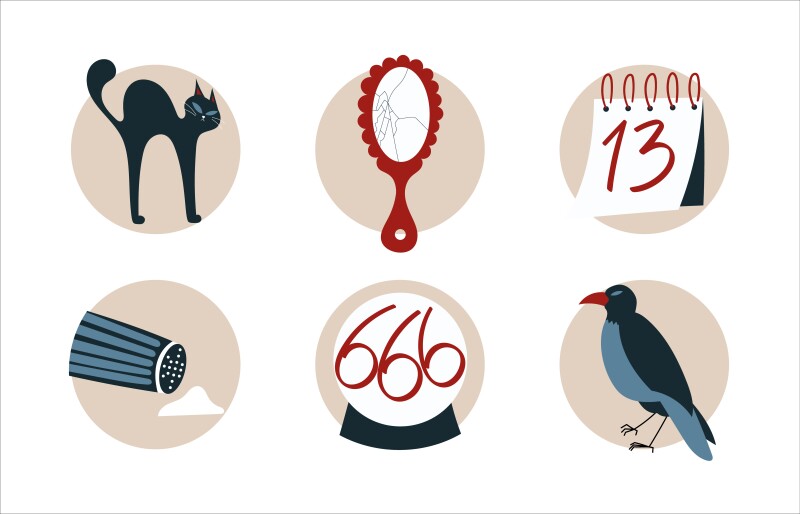Lifestyle
Unraveling the Origins of Spooky Superstitions Worldwide

Superstitions surrounding black cats, Friday the 13th, and broken mirrors have long intrigued people around the world. These beliefs often stem from a mix of mythology, historical events, and cultural practices. Understanding their origins offers insight into why many societies continue to hold these notions today.
Black Cats: From Worship to Fear
The belief that black cats bring bad luck can be traced back to Europe in the Middle Ages. During this period, cats became associated with witchcraft, often seen as companions to witches. Research from Mount St. Joseph University indicates that a papal decree from 1233 by Pope Gregory IX linked black cats to heretical practices, amplifying fear around these animals. This sentiment only intensified during witch hunts, leading to a lasting superstition that eventually crossed the Atlantic with early settlers.
Interestingly, the perception of black cats varies significantly across different cultures. In ancient Egypt, black cats were revered and associated with the goddess Bastet. Conversely, in Japan, a black cat crossing a woman’s path is considered a sign of good fortune in finding a suitor. Additionally, sailors historically regarded a black cat aboard their vessel as a harbinger of a safe journey.
Friday the 13th: A Day of Misfortune
The superstition that Friday the 13th is an unlucky day has deep roots in religious and historical narratives. In Christian tradition, the Last Supper featured thirteen attendees, with Judas Iscariot, the 13th guest, betraying Jesus. This event, combined with the crucifixion of Jesus on a Friday, has contributed to the day’s ominous reputation, according to the Library of Congress Blogs. Some historians speculate that the Christian Church may have promoted negative views of Friday, named after the goddess Frigg or Freya, to diminish pagan practices.
The mass arrest and execution of the Knights Templar on Friday, October 13, 1307, further solidified the day’s negative connotations. In Norse mythology, the god Loki was an uninvited guest at a dinner party that resulted in the death of Balder, adding another layer to the day’s misfortunes. The number 13 itself has long been viewed as unlucky, as it follows the “perfect” number 12, which often symbolizes completion.
Broken Mirrors: Reflections of Misfortune
The superstition surrounding broken mirrors dates back to ancient Roman beliefs. Romans thought that mirrors reflected one’s soul, and thus, breaking a mirror would harm the soul itself. According to the University of South Carolina, this belief led to the notion that it would take seven years for the body and soul to regenerate after the mirror was broken, resulting in a seven-year period of bad luck.
Additionally, damaging a mirror was seen as disrespectful to the gods, inviting divine retribution. Over time, various “remedies” emerged to counteract the bad luck associated with breaking mirrors, such as grinding the shards to dust, burying them, or tossing them into flowing water.
The Ghostly Portal of Facing Mirrors
A particularly eerie superstition involves two mirrors facing each other, believed to create a “ghost portal.” This idea arises from the perception that mirrors can trap spirits or confuse energies, acting as gateways between dimensions. This belief is connected to the notion that mirrors serve as “liminal” spaces, bridging our world and the supernatural.
Cultural variations suggest that this setup can also serve as a doorway for malevolent entities. The infinite reflection created by two facing mirrors is seen as disruptive to the natural flow of energy, potentially allowing confused spirits to move between realms. Some variations even assert that spirits can become trapped in the reflective space, leading to hauntings in the vicinity.
As these superstitions continue to persist, they invite reflection on our cultural histories and the beliefs that shape our understanding of luck and misfortune. Whether one subscribes to these ideas or not, the stories behind them reveal a rich tapestry of human experience and belief.
-

 Science2 months ago
Science2 months agoOhio State Study Uncovers Brain Connectivity and Function Links
-

 Politics2 months ago
Politics2 months agoHamas Chief Stresses Disarmament Tied to Occupation’s End
-

 Science1 month ago
Science1 month agoUniversity of Hawaiʻi Joins $25.6M AI Project for Disaster Monitoring
-

 Entertainment2 months ago
Entertainment2 months agoMegan Thee Stallion Exposes Alleged Online Attack by Bots
-

 Science4 weeks ago
Science4 weeks agoALMA Discovers Companion Orbiting Giant Star π 1 Gruis
-

 Science2 months ago
Science2 months agoResearchers Challenge 200-Year-Old Physics Principle with Atomic Engines
-

 Entertainment1 month ago
Entertainment1 month agoPaloma Elsesser Shines at LA Event with Iconic Slicked-Back Bun
-

 World1 month ago
World1 month agoFDA Unveils Plan to Cut Drug Prices and Boost Biosimilars
-

 Business1 month ago
Business1 month agoMotley Fool Wealth Management Reduces Medtronic Holdings by 14.7%
-

 Top Stories2 months ago
Top Stories2 months agoFederal Agents Detain Driver in Addison; Protests Erupt Immediately
-

 Entertainment1 month ago
Entertainment1 month agoBeloved Artist and Community Leader Gloria Rosencrants Passes Away
-

 Science2 months ago
Science2 months agoInnovator Captures Light at 2 Billion Frames Per Second









